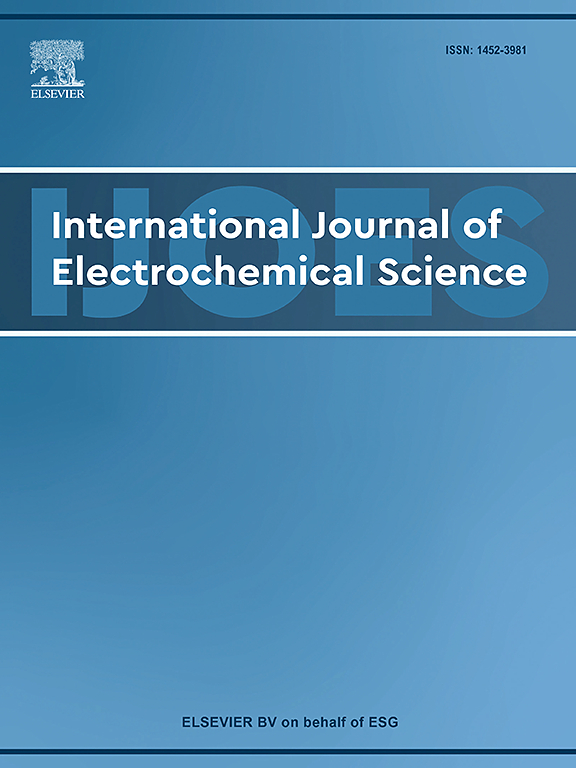Electrochemical evaluation of nanostructured coatings for corrosion protection of structural metals
IF 2.4
4区 化学
Q4 ELECTROCHEMISTRY
International Journal of Electrochemical Science
Pub Date : 2025-10-20
DOI:10.1016/j.ijoes.2025.101214
引用次数: 0
Abstract
Corrosion of steel and other construction metals represents a critical threat to infrastructure durability, and recent advances in nanotechnology have inspired a new generation of protective coatings with superior performance. This review provides a comprehensive analysis of electrochemical methods used to evaluate nanocoatings (nanostructured coatings and nano-additive-modified coatings) and highlights how different classes of nanoscale materials improve corrosion resistance. Techniques such as potentiodynamic polarization, electrochemical impedance spectroscopy, linear polarization resistance, and localized probes not only quantify reductions in corrosion current and increases in charge-transfer resistance, but also clarify the mechanisms by which nanostructured additives function. Inorganic nanoparticles such as silica, titania, and ceria enhance barrier density and adhesion, while layered clays and double hydroxides impart both tortuous diffusion paths and inhibitor release capability. Carbon-based nanomaterials, including graphene, graphene oxide, and carbon nanotubes, offer unique two-dimensional or fibrous architectures that create highly effective barriers, though their long-term behavior depends strongly on dispersion, orientation, and defect control. Conductive polymers and hybrid composites integrate active passivation with structural reinforcement, and self-healing nanocontainer systems demonstrate the ability to autonomously restore protection at damaged sites. By comparing diverse strategies, this review emphasizes the interplay between barrier effects, active inhibition, and mechanical reinforcement, while also recognizing the challenges of durability, scalability, and environmental safety. Overall, electrochemical insights have advanced both the understanding and optimization of nanocoatings, guiding the design of multifunctional systems that can extend service life and reduce maintenance costs for critical infrastructure.
纳米结构金属防腐涂层的电化学评价
钢铁和其他建筑金属的腐蚀对基础设施的耐久性构成了严重威胁,纳米技术的最新进展激发了新一代具有卓越性能的保护涂层。本文综述了用于评价纳米涂层(纳米结构涂层和纳米添加剂改性涂层)的电化学方法,并重点介绍了不同类别的纳米材料如何提高耐腐蚀性。动电位极化、电化学阻抗谱、线性极化电阻和局部探针等技术不仅量化了腐蚀电流的减少和电荷转移电阻的增加,而且还阐明了纳米结构添加剂的作用机制。无机纳米颗粒(如二氧化硅、二氧化钛和二氧化铈)增强了屏障密度和粘附力,而层状粘土和双氢氧化物赋予了弯曲的扩散路径和抑制剂释放能力。碳基纳米材料,包括石墨烯、氧化石墨烯和碳纳米管,提供了独特的二维或纤维结构,可以产生高效的屏障,尽管它们的长期行为在很大程度上取决于分散、取向和缺陷控制。导电聚合物和杂化复合材料将主动钝化与结构增强相结合,自修复纳米容器系统展示了在受损部位自主恢复保护的能力。通过比较不同的策略,本综述强调了屏障效应、主动抑制和机械加固之间的相互作用,同时也认识到耐久性、可扩展性和环境安全性方面的挑战。总的来说,电化学的见解促进了对纳米涂层的理解和优化,指导了多功能系统的设计,可以延长关键基础设施的使用寿命并降低维护成本。
本文章由计算机程序翻译,如有差异,请以英文原文为准。
求助全文
约1分钟内获得全文
求助全文
来源期刊
CiteScore
3.00
自引率
20.00%
发文量
714
审稿时长
2.6 months
期刊介绍:
International Journal of Electrochemical Science is a peer-reviewed, open access journal that publishes original research articles, short communications as well as review articles in all areas of electrochemistry: Scope - Theoretical and Computational Electrochemistry - Processes on Electrodes - Electroanalytical Chemistry and Sensor Science - Corrosion - Electrochemical Energy Conversion and Storage - Electrochemical Engineering - Coatings - Electrochemical Synthesis - Bioelectrochemistry - Molecular Electrochemistry

 求助内容:
求助内容: 应助结果提醒方式:
应助结果提醒方式:


